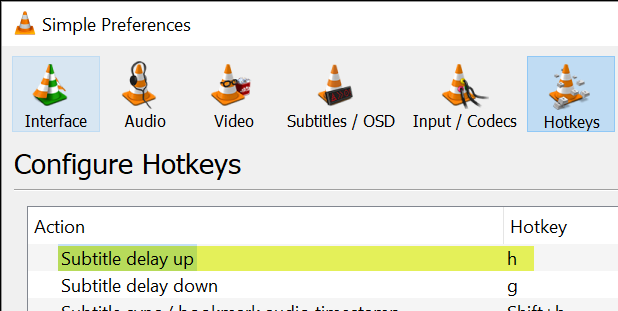Hello there. Thanks for watching my YouTube video (How to Learn English with Movies). On this page, you’ll find additional information to help you get started with the Delay-Subtitles technique.

How to Delay Subtitles in Movies
The easiest way is to use a media player called VLC.
With VLC, you can delay subtitles by pressing the H key on your keyword. Each time you press the H key, the subtitles are delayed by 50 milliseconds. So, to delay the subtitles for 2 seconds, just press the H key 20 times (until it shows 2000 ms).

If you’ve accidentally delayed the subtitles too much (say 2200 ms), press the G key to make them appear sooner.
How to Read Subtitles Quickly
When you begin to learn English with this approach, you’ll find that, sometimes, you can’t keep up with the subtitles (especially if you’re not very good at reading in English).
But don’t worry. I have a few tips on how to deal with this problem.
Tip #1: simply ignore the subtitles.
When you watch a movie, there will be some sentences that don’t contain any important information.
It doesn’t matter if you don’t understand these sentences. They aren’t important to the overall plot and can be ignored.
Let me give you an example.
Suppose you’re watching a scene where a helicopter is about to crash, and the pilot and the passengers are yelling something to each other; something you don’t understand. In this case, it’s not a big deal if you don’t know what they’re saying because:
- You can easily guess what they’re talking about. (They’re probably talking about how to prevent the helicopter from crashing, the reason the helicopter is crashing, or something along those lines)
- Even if you don’t know what they’re saying, it will not affect your understanding of the overall plot.
In a scene like this where visuals are more important than dialogues, you don’t have to read the subtitles. Just focus on the visuals and the audio.
Tip #2: read only the words you don’t understand.
This one is self-explanatory. Sometimes, you’ll miss just one or two words in a sentence. In this case, you can simply glance at the word(s) you missed while ignoring the rest of the sentence. You don’t have to read every word from left to right.
But what if you don’t understand the whole sentence? What do you do?
In this case, read tip #3.
Tip #3: skim the subtitles.
Skim means to read something quickly to note only the important points. This is what some people do unconsciously when watching a movie with subtitles.
Here’s how to do it: instead of reading every single word from left or right, you scan the subtitles quickly to gather as much information as possible.
It’s a bit hard to explain, but what I mean is to quickly look at the words on the screen and let your brain recognize the most important words. Usually you just need to see 4 words out of 7 to understand the meaning of the sentence without reading all the conjunctions, prepositions, and so on.
With this technique, you’ll be able to read the subtitles with a lot less time. It’s a little hard to do at first, but once you get past the learning curve, reading subtitles this way will become natural.
Tip #4: pause only when necessary.
If you’re watching a movie with a complicated plot, you might have to pause sometimes to read the subtitles and think about the meaning.
However, I suggest trying to avoid pausing/rewinding as much as possible. Don’t pause or go back unless it’s important. This way, you’ll have to force yourself into reading faster so you don’t miss anything.
Tip #5: practice a lot (watch a lot of subbed movies).
This is the most important tip of all. Reading subtitles quickly is a skill. And just like every other skill, it requires practice. If you want to get good at it, you simply have to watch a lot of subbed movies.
In fact, if you practice a lot, you don’t even have to remember the previous four tips. You’ll unconsciously develop those techniques without even realizing:
- You’ll get better at locating the words you miss on the screen (while ignoring the rest).
- You’ll get better at getting the gist (key information) with just a quick look at the text on screen.
- Most importantly, your listening will improve and you’ll get used to some common words, phrases, idioms, etc. You will understand them without needing to read the subtitles. That’s how you learn a language!
Frequently-Asked Questions
What are the titles of the movie clips in your video?
- Harry Potter and the Prisoner of Azkaban
- Flipped
The text sometimes appears before the actor finishes the sentence. What should I do?
This is normal. Oftentimes, the text will appear before the actor finishes talking. When this happens, try to resist the temptation to look at the text.
Wait until the actor finishes talking, and if you don’t understand, then look at the subtitles. If the actor is talking fast, you can use the speed reading techniques I’ve shared earlier (or you can simply pause the movie).
Now, I have to admit that this is quite difficult to do because our eyes tend to read text on screen automatically. So, don’t worry if you can’t follow this advice from time to time. Just do your best.
I’ve practiced listening using this approach for a long time. But I still have to rely on subtitles. And I still can’t understand native speakers sometimes. What’s wrong with me?
There’s nothing wrong with you. Even native speakers have trouble understanding movies sometimes. In fact, some native speakers like to watch movies with subtitles because it helps them understand better.
What makes English difficult to understand is that there are various English accents. Even in the same English-speaking country, people who live in different regions have their own regional accents. So, it’s not uncommon for native speakers from one part of the world to have trouble understanding native speakers from another part.
My point is this: if native speakers have trouble understanding each other, there’s no reason for you to feel bad about it. Focus on progress, not perfection.
This technique sucks! It’s more effective to watch each movie many times. If you don’t repeat, you won’t remember new vocabulary. Learning new information requires a lot of repetition.
First of all, I never claim that this is the most effective way to learn English. I came up with this technique simply because it allows me to learn English through movies without getting bored.
Sure. I’ll probably get better results by watching the same movie many times. But I’m not going to do that. Why? Because it’s sad and boring. My life is not just about learning English. I have other interests and hobbies to pursue. I’m not going to spend hours each day learning English that way.
So, if you have a lot of free time to spend, feel free to ignore this technique. It’s up to you 🙂
In one of your old videos, You told us not to practice listening with movies. But in this new video, you’re telling us how to improve our listening with movies. Are you contradicting yourself?
I can understand the confusion. But you have to understand that when I made that old video, I had not come up with this delay-subtitles technique yet. That’s why I said in the old video that watching movies with subtitles is a terrible way to improve your listening (because you aren’t listening, you’re simply reading the subtitles).
But now that I’ve discovered this technique, everything’s changed. Now it’s OK to practice listening with movies as long as you delay the subtitles.

